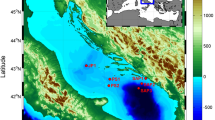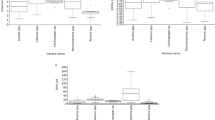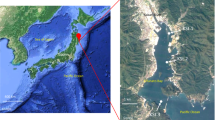Abstract
Microorganisms remineralize and respire half of marine primary production, yet the niches occupied by specific microbial groups, and how these different groups may interact, are poorly understood. In this study, we identify co-occurrence patterns for marine Archaea and specific bacterial groups in the chlorophyll maximum of the Southern California Bight. Quantitative PCR time series of marine group 1 (MG1) Crenarchaeota 16S rRNA genes varied substantially over time but were well-correlated (r2=0.94, P<0.001) with ammonia monooxygenase subunit A (amoA) genes, and were more weakly related to 16S rRNA genes for all Archaea (r2=0.39), indicating that other archaeal groups (for example, Euryarchaeota) were numerically important. These data sets were compared with variability in bacterial community composition based on automated ribosomal intergenic spacer analysis (ARISA). We found that archaeal amoA gene copies and a SAR11 (or Pelagibacter) group Ib operational taxonomic unit (OTU) displayed strong co-variation through time (r2=0.55, P<0.05), and archaeal amoA and MG1 16S rRNA genes also co-occurred with two SAR86 and two Bacteroidetes OTUs. The relative abundance of these groups increased and decreased in synchrony over the course of the time series, and peaked during periods of seasonal transition. By using a combination of quantitative and relative abundance estimates, our findings show that abundant microbial OTUs—including the marine Crenarchaeota, SAR11, SAR86 and the Bacteroidetes—co-occur non-randomly; they consequently have important implications for our understanding of microbial community ecology in the sea.
Similar content being viewed by others
Log in or create a free account to read this content
Gain free access to this article, as well as selected content from this journal and more on nature.com
or
References
Agogue H, Brink M, Dinasquet J, Herndl GJ . (2008). Major gradients in putatively nitrifying and non-nitrifying Archaea in the deep North Atlantic. Nature 456: 788–791.
Azam F, Fenchel T, Field JG, Gray JS, Meyer-Reil LA, Thingstad F . (1983). The ecological role of water column microbes in the sea. Mar Ecol Prog Ser 10: 257–263.
Bauer M, Kube M, Teeling H, Richter M, Lombardot T, Allers E et al. (2006). Whole genome analysis of the marine Bacteroidetes Gramella forsetii reveals adaptations to degradation of polymeric organic matter. Environ Microbiol 8: 2201–2213.
Beja O, Spudich EN, Spudich JL, Leclerc M, DeLong EF . (2001). Proteorhodopsin phototrophy in the ocean. Nature 411: 786–789.
Beja O, Aravind L, Koonin EV, Suzuki MT, Hadd A, Nguyen LP et al. (2000). Bacterial Rhodopsin: Evidence for a New Type of Phototrophy in the Sea. Science 289: 1902–1906.
Beman JM, Sachdeva R, Fuhrman JA . (2010). Population ecology of nitrifying Archaea and Bacteria in the Southern California Bight. Environ Microbiol 12: 1282–1292.
Beman JM, Popp BN, Francis CA . (2008). Molecular and biogeochemical evidence for ammonia oxidation by marine Crenarchaeota in the Gulf of California. The ISME J 2: 429–441.
Brown MV, Fuhrman JA . (2005). Marine bacterial microdiversity as revealed by internal transcribed spacer analysis. Aquat Microb Ecol 41: 15–23.
Brown MV, Schwalbach M, Hewson I, Fuhrman JA . (2005). Coupling 16S-ITS rDNA clone libraries and automated ribosomal intergenic spacer analysis to show marine microbial diversity: development and application to a time series. Environ Microbiol 7: 1466–1479.
Carlson CA, Morris R, Parsons R, Treusch AH, Giovannoni SJ, Vergin K . (2009). Seasonal dynamics of SAR11 populations in the euphotic and mesopelagic zones of the northwestern Sargasso Sea. ISME J 3: 283–295.
Church MJ, Wai B, Karl DM, DeLong EF . (2010). Abundances of crenarchaeal amoA genes and transcripts in the Pacific Ocean. Environ Microbiol 12: 679–688.
Clark C, Schmidt EL . (1966). Effect of Mixed Culture on Nitrosomonas europaea Simulated by Uptake and Utilization of Pyruvate. J Bacteriol 91: 367–373.
Cottrell MT, Kirchman DL . (2000a). Community Composition of Marine Bacterioplankton Determined by 16S rRNA Gene Clone Libraries and Fluorescence In Situ Hybridization. Appl Environ Microbiol 66: 5116–5122.
Cottrell MT, Kirchman DL . (2000b). Natural Assemblages of Marine Proteobacteria and Members of the Cytophaga-Flavobacter Cluster Consuming Low- and High-Molecular-Weight Dissolved Organic Matter. Appl Environ Microbiol 66: 1692–1697.
de la Torre JR, Walker CB, Ingalls AE, Konneke M, Stahl DA . (2008). Cultivation of a thermophilic ammonia oxidizing archaeon synthesizing crenarchaeol. Environ Microbiol 10: 810–818.
Eiler A, Hayakawa DH, Church MJ, Karl DM, Rappé MS . (2009). Dynamics of the SAR11 bacterioplankton lineage in relation to environmental conditions in the oligotrophic North Pacific subtropical gyre. Environ Microbiol 11: 2291–2300.
Eilers H, Pernthaler J, Glockner FO, Amann R . (2000). Culturability and In Situ Abundance of Pelagic Bacteria from the North Sea. Appl Environ Microbiol 66: 3044–3051.
Erguder TH, Boon N, Wittebolle L, Marzorati M, Verstraete W . (2009). Environmental factors shaping the ecological niches of ammonia-oxidizing archaea. FEMS Microbiol Rev 33: 855–869.
Field CB, Behrenfeld MJ, Randerson JT, Falkowski P . (1998). Primary Production of the Biosphere: Integrating Terrestrial and Oceanic Components. Science 281: 237–240.
Field K, Gordon D, Wright T, Rappe M, Urback E, Vergin K et al. (1997). Diversity and depth-specific distribution of SAR11 cluster rRNA genes from marine planktonic bacteria. Appl Environ Microbiol 63: 63–70.
Fisher MM, Triplett EW . (1999). Automated approach for ribosomal intergenic spacer analysis of microbial diversity and its application to freshwater bacterial communities. Appl Environ Microbiol 65: 4630–4636.
Francis CA, Beman JM, Kuypers MMM . (2007). New processes and players in the nitrogen cycle: the microbial ecology of anaerobic and archaeal ammonia oxidation. ISME J 1: 19–27.
Francis CA, Roberts KJ, Beman JM, Santoro AE, Oakley BB . (2005). Ubiquity and diversity of ammonia-oxidizing archaea in water columns and sediments of the ocean. Proc Natl Acad Sci USA 102: 14683–14688.
Frias-Lopez J, Shi Y, Tyson GW, Coleman ML, Schuster SC, Chisholm SW et al. (2008). Microbial community gene expression in ocean surface waters. Proc Natl Acad Sci USA 105: 3805–3810.
Frigaard N, Martinez A, Mincer TJ, DeLong EF . (2006). Proteorhodopsin lateral gene transfer between marine planktonic Bacteria and Archaea. Nature 439: 847–850.
Fuhrman JA, McCallum K, Davis AA . (1992). Novel major archaebacterial group from marine plankton. Nature 356: 148–149.
Fuhrman JA, Azam F . (1982). Thymidine incorporation as a measure of heterotrophic bacterioplankton production in marine surface waters: evaluation and field results. Mar Biol 66: 109–120.
Fuhrman JA . (2009). Microbial community structure and its functional implications. Nature 459: 193–199.
Fuhrman JA, Schwalbach MS, Stingl U . (2008). Proteorhodopsins: an array of physiological roles? Nat Rev Micro 6: 488–494.
Fuhrman JA, Hewson I, Schwalbach MS, Steele JA, Brown MV, Naeem S . (2006). Annually reoccurring bacterial communities are predictable from ocean conditions. Proc Natl Acad Sci USA 103: 13104–13109.
Fuhrman JA, Comeau DE, Hagstrom A, Chan AM . (1988). Extraction from Natural Planktonic Microorganisms of DNA Suitable for Molecular Biological Studies. Appl Environ Microbiol 54: 1426–1429.
García-Martínez J, Rodríguez-Valera F . (2000). Microdiversity of uncultured marine prokaryotes: the SAR11 cluster and the marine Archaea of Group I. Mol Ecol 9: 935–948.
Giovannoni SJ, Bibbs L, Cho J, Stapels MD, Desiderio R, Vergin KL et al. (2005a). Proteorhodopsin in the ubiquitous marine bacterium SAR11. Nature 438: 82–85.
Giovannoni SJ, Britschgi TB, Moyer CL, Field KG . (1990). Genetic diversity in Sargasso Sea bacterioplankton. Nature 345: 60–63.
Giovannoni SJ, Tripp HJ, Givan S, Podar M, Vergin KL, Baptista D et al. (2005b). Genome Streamlining in a Cosmopolitan Oceanic Bacterium. Science 309: 1242–1245.
Glockner FO, Fuchs BM, Amann R . (1999). Bacterioplankton Compositions of Lakes and Oceans: a First Comparison Based on Fluorescence In Situ Hybridization. Appl Environ Microbiol 65: 3721–3726.
Gomez-Consarnau L, Gonzalez JM, Coll-Llado M, Gourdon P, Pascher T, Neutze R et al. (2007). Light stimulates growth of proteorhodopsin-containing marine Flavobacteria. Nature 445: 210–213.
González JM, Fernández-Gómez B, Fernàndez-Guerra A, Gómez-Consarnau L, Sánchez O, Coll-Lladó M et al. (2008). Genome analysis of the proteorhodopsin-containing marine bacterium Polaribacter sp. MED152 (Flavobacteria). Proc Natl Acad Sci USA 105: 8724–8729.
Gundersen K . (1955). Observations on mixed cultures of nitrosomonas and heterotrophic soil bacteria. Plant Soil 7: 26–34.
Hallam SJ, Mincer TJ, Schleper C, Preston CM, Roberts K, Richardson PM et al. (2006). Pathways of carbon assimilation and ammonia oxidation suggested by environmental genomic analyses of marine Crenarchaeota. PLoS Biology 4: e95.
Hatzenpichler R, Lebedeva EV, Spieck E, Stoecker K, Richter A, Daims H et al. (2008). A moderately thermophilic ammonia-oxidizing crenarchaeote from a hot spring. Proc Natl Acad Sci USA 105: 2134–2139.
Hayward TL, Venrick EL . (1998). Nearsurface patterns in the California Current: coupling between physical and biological structure. Deep Sea Res Part II: Top Stud Oceanogr 45: 1617–1638.
Hickey BM . (1979). The California current system—hypotheses and facts. Prog Oceanogr 8: 191–279.
Jones RD, Hood MA . (1980). Interaction between an ammonium-oxidizer, Nitrosomonas sp., and two heterotrophic bacteria, Nocardia atlantica and Pseudomonas sp. A note. Microb Ecol 6: 271–275.
Karner MB, DeLong EF, Karl DM . (2001). Archaeal dominance in the mesopelagic zone of the Pacific Ocean. Nature 409: 507–510.
Kirchman DL . (2008). New light on an important microbe in the ocean. Proc Natl Acad Sci 105: 8487–8488.
Könneke M, Bernhard AE, de la Torre JR, Walker CB, Waterbury JB, Stahl DA . (2005). Isolation of an autotrophic ammonia-oxidizing marine archaeon. Nature 437: 543–546.
Lam P, Lavik G, Jensen MM, van dV, Schmid M, Woebken D et al. (2009). Revising the nitrogen cycle in the Peruvian oxygen minimum zone. Proc Natl Acad Sci USA 106: 4752–4757.
Lam P, Jensen MM, Lavik G, McGinnis DF, Muller B, Schubert CJ et al. (2007). Linking crenarchaeal and bacterial nitrification to anammox in the Black Sea. Proc Natl Acad Sci USA 104: 7104–7109.
Leininger S, Urich T, Schloter M, Schwark L, Qi J, Nicol GW et al. (2006). Archaea predominate among ammonia-oxidizing prokaryotes in soils. Nature 442: 806.
Lomas MW, Lipschultz F . (2006). Forming the primary nitrite maximum: nitrifiers or phytoplankton? Limnol Oceanog 51: 2453–2467.
Lynn RJ, Simpson JJ . (1987). The California Current System: The Seasonal Variability of its Physical Characteristics. J Geophys Res 92: 12947–12966.
Martens-Habbena W, Berube PM, Urakawa H, de lT, Stahl DA . (2009). Ammonia oxidation kinetics determine niche separation of nitrifying Archaea and Bacteria. Nature 461: 976–979.
Massana R, Murray A, Preston C, DeLong E . (1997). Vertical distribution and phylogenetic characterization of marine planktonic Archaea in the Santa Barbara Channel. Appl Environ Microbiol 63: 50–56.
Mincer TJ, Church MJ, Taylor LT, Preston CM, Karl DM, DeLong EF . (2007). Quantitative distribution of presumptive archaeal and bacterial nitrifiers in Monterey Bay and the North Pacific Subtropical Gyre. Environ Microbiol 9: 1162–1175.
Moran MA, Miller WL . (2007). Resourceful heterotrophs make the most of light in the coastal ocean. Nat Rev Micro 5: 792–800.
Morris RM, Vergin KL, Jang-Cheon Cho, Rappé MS, Carlson CA, Giovannoni SJ . (2005). Temporal and Spatial Response of Bacterioplankton Lineages to Annual Convective Overturn at the Bermuda Atlantic Time-Series Study Site. Limnol Oceanogr 50: 1687–1696.
Morris RM, Rappe MS, Connon SA, Vergin KL, Siebold WA, Carlson CA et al. (2002). SAR11 clade dominates ocean surface bacterioplankton communities. Nature 420: 806–810.
Pinhassi J, Sala MM, Havskum H, Peters F, Guadayol O, Malits A et al. (2004). Changes in Bacterioplankton Composition under Different Phytoplankton Regimens. Appl Environ Microbiol 70: 6753–6766.
Prosser JI, Nicol GW . (2008). Relative contributions of archaea and bacteria to aerobic ammonia oxidation in the environment. Environ Microbiol 10: 2931–2941.
Riemann L, Steward GF, Azam F . (2000). Dynamics of Bacterial Community Composition and Activity during a Mesocosm Diatom Bloom. Appl Environ Microbiol 66: 578–587.
Ruan Q, Dutta D, Schwalbach MS, Steele JA, Fuhrman JA, Sun F . (2006). Local similarity analysis reveals unique associations among marine bacterioplankton species and environmental factors. Bioinformatics 22: 2532–2538.
Santoro AE, Casciotti KL, Francis CA . (2010). Activity, abundance and diversity of nitrifying archaea and bacteria in the central California Current. Environ Microbiol 12: 1989–2006.
Schwalbach M, Brown MV, Fuhrman JA . (2005). Impact of light on marine bacterioplankton community structure. Aquat Microb Ecol 39: 235–245.
Simon M, Azam F . (1989). Protein content and protein synthesis rates of planktonic marine bacteria. Mar Ecol Prog Ser 51: 201–213.
Sogin ML, Morrison HG, Huber JA, Welch DM, Huse SM, Neal PR et al. (2006). Microbial diversity in the deep sea and the underexplored ‘rare biosphere’. Proc Natl Acad Sci USA 103: 12115–12120.
Steinmüller W, Bock E . (1976). Growth of Nitrobacter in the presence of organic matter. Arch Microbiol 108: 299–304.
Stingl U, Tripp HJ, Giovannoni SJ . (2007). Improvements of high-throughput culturing yielded novel SAR11 strains and other abundant marine bacteria from the Oregon coast and the Bermuda Atlantic Time Series study site. ISME J 1: 361–371.
Takai K, Horikoshi K . (2000). Rapid detection and quantification of members of the archaeal community by quantitative pcr using fluorogenic probes. Appl Environ Microbiol 66: 5066–5072.
Teske A, Sorensen KB . (2007). Uncultured archaea in deep marine subsurface sediments: have we caught them all? ISME J 2: 3–18.
Venrick EL . (2002). Floral patterns in the California Current System off southern California: 1990–1996. J Mar Res 60: 171–189.
Venter JC, Remington K, Heidelberg JF, Halpern AL, Rusch D, Eisen JA et al. (2004). Environmental genome shotgun sequencing of the Sargasso Sea. Science 304: 66–74.
Wuchter C, Abbas B, Coolen MJL, Herfort L, van Bleijswijk J, Timmers P et al. (2006). Archaeal nitrification in the ocean. Proc Natl Acad Sci USA 103: 12317–12322.
Acknowledgements
We thank Troy Gunderson, Rohan Sachdeva, Anand Patel, Cheryl Chow and Mahira Kakajiwala for help in the field and lab, and the officers and crew of the R/V Sea Watch. This work was supported by US National Science Foundation awards OCE-0623575 and 0703159, and the USC Wrigley Institute for Environmental Studies.
Author information
Authors and Affiliations
Corresponding author
Ethics declarations
Competing interests
The authors declare no conflict of interest.
Additional information
Supplementary Information accompanies the paper on The ISME Journal website
Rights and permissions
About this article
Cite this article
Beman, J., Steele, J. & Fuhrman, J. Co-occurrence patterns for abundant marine archaeal and bacterial lineages in the deep chlorophyll maximum of coastal California. ISME J 5, 1077–1085 (2011). https://doi.org/10.1038/ismej.2010.204
Received:
Revised:
Accepted:
Published:
Issue date:
DOI: https://doi.org/10.1038/ismej.2010.204
Keywords
This article is cited by
-
Spatiotemporal Dynamics of Bacterial Taxonomic and Functional Profiles in Estuarine Intertidal Soils of China Coastal Zone
Microbial Ecology (2023)
-
Statistical significance approximation for local similarity analysis of dependent time series data
BMC Bioinformatics (2019)
-
Characterization of bacterial and microbial eukaryotic communities associated with an ephemeral hypoxia event in Taihu Lake, a shallow eutrophic Chinese lake
Environmental Science and Pollution Research (2018)
-
Ecological diversity and co-occurrence patterns of bacterial community through soil profile in response to long-term switchgrass cultivation
Scientific Reports (2017)
-
Marine archaeal dynamics and interactions with the microbial community over 5 years from surface to seafloor
The ISME Journal (2017)



